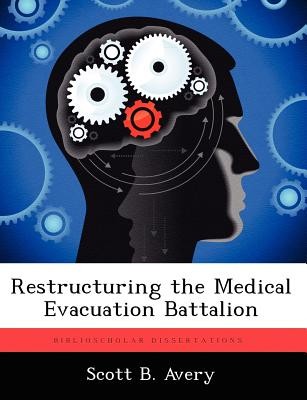
- We will send in 10–14 business days.
- Author: Scott B Avery
- Publisher: BiblioScholar
- ISBN-10: 1249285739
- ISBN-13: 9781249285731
- Format: 18.9 x 24.6 x 0.6 cm, softcover
- Language: English
- SAVE -10% with code: EXTRA
Reviews
Description
This thesis investigates whether the Army Medical Department (AMEDD) should restructure the medical evacuation battalion. The structure chosen allows the AMEDD to deploy, train, and command medical assets during peace and war. Whether the AMEDD should restructure is a topic of debate as is the most advantageous assignment of medical evacuation units. Medical evacuation units are currently assigned to the corps with their command and control coming from the medical evacuation battalion. The study investigates how to form battalions and the implications of regional command and control. Also considered is the duplication in the logistical assets inherent to regionally commanded and separately deployable units. This study compares three organizational structures using the force integration functional areas (structuring, equipping, training, manning, sustaining, deploying, stationing, funding, and readiness). The study promotes restructuring the medical evacuation battalion using an Aviation Restructure Initiative (ARI) model and stationing units together with the battalion headquarters. Restructuring the battalion coupled with stationing changes facilitated by the use of the multicomponent unit concept enhances the evacuation capability without increasing the total number of personnel. A change to this structure will allow for trained, cohesive, modular units better able to meet future demands throughout the spectrum of conflict.
EXTRA 10 % discount with code: EXTRA
The promotion ends in 18d.06:17:49
The discount code is valid when purchasing from 10 €. Discounts do not stack.
- Author: Scott B Avery
- Publisher: BiblioScholar
- ISBN-10: 1249285739
- ISBN-13: 9781249285731
- Format: 18.9 x 24.6 x 0.6 cm, softcover
- Language: English English
This thesis investigates whether the Army Medical Department (AMEDD) should restructure the medical evacuation battalion. The structure chosen allows the AMEDD to deploy, train, and command medical assets during peace and war. Whether the AMEDD should restructure is a topic of debate as is the most advantageous assignment of medical evacuation units. Medical evacuation units are currently assigned to the corps with their command and control coming from the medical evacuation battalion. The study investigates how to form battalions and the implications of regional command and control. Also considered is the duplication in the logistical assets inherent to regionally commanded and separately deployable units. This study compares three organizational structures using the force integration functional areas (structuring, equipping, training, manning, sustaining, deploying, stationing, funding, and readiness). The study promotes restructuring the medical evacuation battalion using an Aviation Restructure Initiative (ARI) model and stationing units together with the battalion headquarters. Restructuring the battalion coupled with stationing changes facilitated by the use of the multicomponent unit concept enhances the evacuation capability without increasing the total number of personnel. A change to this structure will allow for trained, cohesive, modular units better able to meet future demands throughout the spectrum of conflict.


Reviews